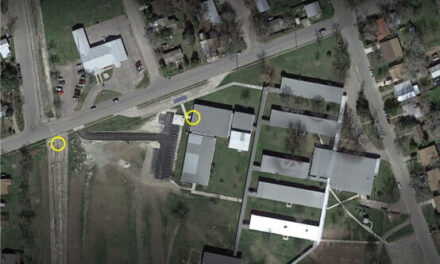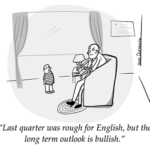The journalistic results outweigh journalists’ squeamishness and reluctance around the process.
By Issac J. Bailey
I’ve been in journalism long enough, about a quarter of a century, to know that the word “bias” affects journalists like few other words.
We love to be labeled fair and accurate and objective, no matter if we write opinion pieces or straight news, no matter if objectivity is objectively an impossibility, given that each of us will forever be influenced (and hamstrung) by our unique combination of experiences, background, and genetic makeup.
We can, if necessary, correct seemingly honest mistakes and misinterpretations that pop up in our work and apologize and explain to our audience how we plan to avoid them in the future.
But to be accused of “liberal bias” cuts because it potentially curtails the reach of our work. It can lead to more distrust and cynicism.
And to be accused of “racial bias” cuts deeper still, because it doesn’t feel like just another critique of our work, but a condemnation of who we fundamentally are.
I suspect that’s why it’s so hard for journalists to embrace anti-implicit bias training or other forms of antibias training. Because to even accept the need for such training can feel like a self-betrayal and may open up an avenue for unfair attacks.
That might be especially true for white journalists. But even journalists of color can improve their work with such training.
Sign up here for a free newsletter featuring the week’s best education news and newsroom comings and goings.
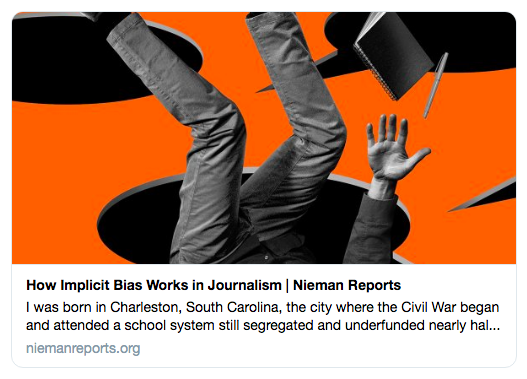
Bailey authored How Implicit Bias Works in Journalism, an important 2018 overview of implicit bias and efforts by newsrooms to combat its effects.
I didn’t realize I needed antibias training until looking back on the stories I missed while covering everything from local real estate markets to the manufacturing industry.
I could have used it when my work dripped with stereotypical language about Harley-Davidson drivers. I deemed a group of 200,000 motorcyclists during an annual Bike Week in tourism mecca Myrtle Beach, S.C., as old, graying white men when the group was much more diverse. That gave readers a skewed and distorting view that made it more difficult for them to grapple with the myriad complexities at play, particularly when my former newspaper compared that event to a mostly black one.
That’s why I hope the reticence to fully embrace antibias training, which I have noticed among former colleagues and many others, is finally lessening — especially among journalists who are spending more time trying to understand and better report on education-related issues.
Education journalists must understand the history of segregation and how it has (and hasn’t) changed, evolving definitions of racial and other forms of identity, the long-simmering debate about IQ and educational achievement, how the country’s drastic demographic shifts are affecting students and how they view themselves, and how others view them, among many other things.
Those issues are becoming more pressing, making antibias training more urgent.
For more about bias, check out PDK’s story about racial equity training for educators and former superintendent Josh Starr’s essay on the need for journalists to look inside schools and classrooms to help readers understand equity and bias issues.
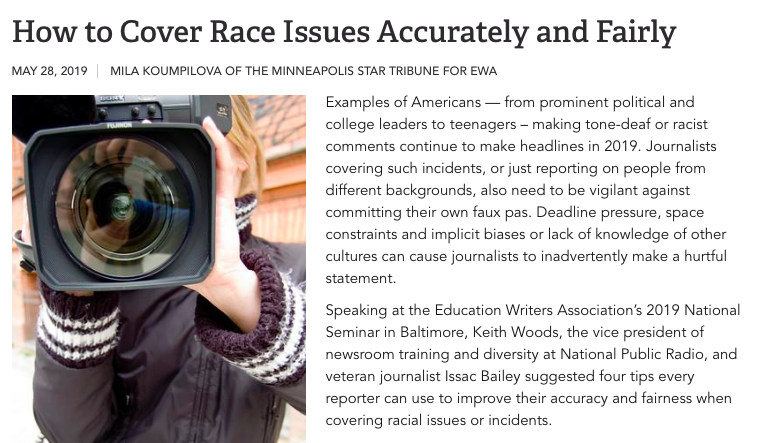
Bailey appeared on a panel at the recent Education Writers Association conference in Baltimore, written up in How to Cover Race Issues Accurately and Fairly.
Take, for example, a recent Washington Post story titled Amid a life of poverty and torment, the cello became his instrument of survival. The nearly 2,500-word feature focuses on Eddie Adams, a talented but poverty-stricken black college student trying to overcome an enormous set of obstacles that followed him from his high school years.
The writing is eloquent, the visuals stirring. It’s the kind of package that tugs at hearts, engages minds, and can make the life of a struggling young man better while dismantling stereotypes about young black men and education. But for some reason, the complex phenomenon called “acting white” was introduced into the piece, without the necessary context. In so doing, the piece unintentionally suggests that black people believe educational excellence is the sole domain of white people, a notion that was never true — black people literally put their lives on the line to become educated — but is still bandied about in some circles even though it’s been debunked.
I’ve sent questions to the writer asking why, but I suspect it was likely something Adams emphasized, making it difficult to ignore. But journalists must provide readers invaluable context to better understand such an emotionally charged issue, which is rooted in this country’s vexing racial history. Falling to do so is a subtle reporting oversight that can unwittingly mislead and fuel racial stereotypes.
The Post story needed to address the shortcomings of the body of research that links the “acting white” phenomenon to lower levels of academic achievement among black people and also take into account the way the personal identity — and personal views — of high-achieving black students growing up in difficult circumstances often change when they’ve had time to fully reflect on why they faced the challenges they did.
To learn more about how the media covers education, follow The Grade on Twitter and Facebook.
“When you’re a white journalist and you grew up in a community where your interactions with police were respectful, where your schools aren’t segregated and you have quality teachers, that’s definitely going to bleed into how you’re covering schools,” said the New York Times’ Nikole Hannah-Jones in a 2016 MMFA video.
We should never assume a writer’s intention when such an oversight occurs. But antibias training is designed to lessen the odds that they will be repeated. Regardless, journalists have too often balked when such a suggestion is made, even though they freely accept that SEO, data collection, video, and other forms of training can make us better journalists without thinking such training reveals a defect in our journalistic character.
Why is it so hard to embrace antibias training that can help eliminate blind spots?
“If you are told to do this, you feel like you are being told that you are a bigot, and that strikes at the core of people feeling bad about themselves,” said Francisco Vara-Orta, the training director for Investigative Reporters and Editors and a former education reporter for a daily paper in Texas and Education Week. “But every person can benefit from the training.”
During his career, Vara-Orta hasn’t received much in the way of formal antibias training, and it wasn’t top of mind for many of his editors. But he made it a priority anyway. He took a discrimination and public policy course at the University of Missouri and benefited from an unconscious bias training session at an Education Writers Association (EWA) conference. He researched race and diversity in newsrooms for his master’s degree thesis.
Even though he has a diverse background as a first-generation college student, product of a single-parent household, openly gay, and Mexican American, Vara-Orta believes that antibias training is necessary because diversity manifests itself in so many ways journalists, white and nonwhite, can’t anticipate.
From Vara-Orta’s view, the most effective training must deal with content as well as hiring decisions. And there must also be practical, concrete ways to measure progress. Journalists should gather data on the diversity, or lack thereof, prevalent in their own work in the way they do on other metrics. That should include revamping the source list, one of the most important factors in coverage decisions. It’s difficult to consistently produce work that reflects the range of ideas, backgrounds, and ethnicities in a particular coverage area if the journalist’s source list doesn’t reflect those things.
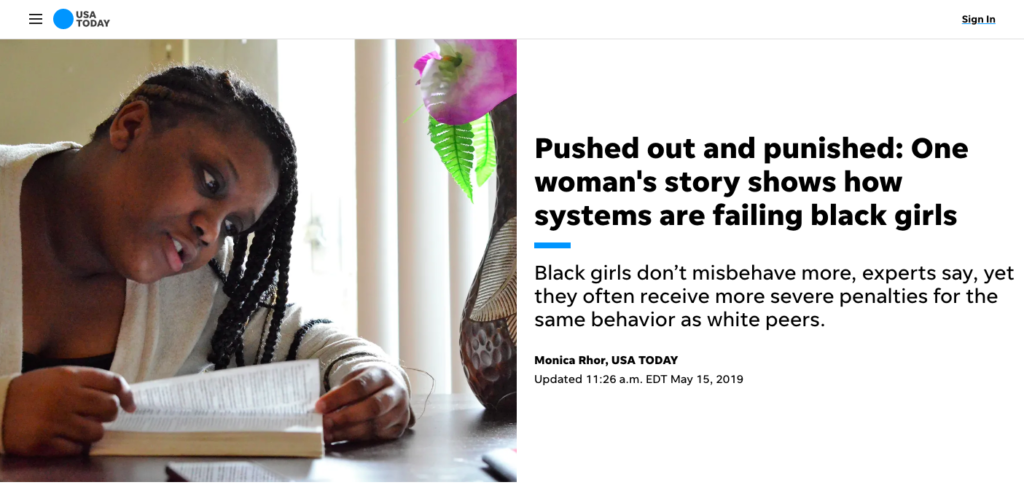
“I’m Latina, but we all carry biases of some kind or another,” says journalist Mónica Rhor, who wrote Racism in school: Black girls punished more harshly than white girls. “We have to be honest with ourselves.”
In recent years, EWA has increased its focus on antibias and diversity training, including sessions during EWA’s national seminars. Full disclosure: I was a panelist during an hour-long anti-bias seminar at the EWA’s most recent national conference.
“We know that it’s difficult these days for newsrooms to provide training on a lot of high-priority concerns,” said EWA’s public editor Emily Richmond. “That’s one reason why EWA has made it a priority to try and help fill those gaps.”
“When we do offer this kind of training the response is extremely positive, and we see consistently strong attendance at these sessions,” Richmond said.
Richmond says she has seen the positive effects of having more journalists considering how bias can unintentionally affect their work.
For example, Mónica Rhor of USA Today spent a year researching how and why black girls were being disciplined at higher rates and more harshly than other students.
During that process, Rhor took steps other journalists should adopt, including being aware of rather than afraid of her own biases and taking concrete steps to counteract them. “I had people of color, black women, read my story, read my draft, to check me,” Rhor told EWA Radio last month.
“I’m Latina, but we all carry biases of some kind or another. Writing about a young black woman whose experiences were very different than mine, I could not even imagine some of the things she went through … We have to be honest with ourselves. We have to really look at, what am I thinking? What is my preconceived notion?”
It will take that kind of reporting humility, and more, to improve education journalism, because holes can show up even in some of our best work.
I know this because I’ve had personal and professional experiences and have spent the past couple of decades studying and reflecting on them.
Antibias training has helped me better understand what can seem like conflicting truths. It can help education journalists as well.
Related posts from The Grade
Race and reporting: Why more journalists need to take us inside schools (Josh Starr)
Why so little diversity training for education journalists?
Seven resources to help education journalists avoid racial blind spots
ABOUT THE AUTHOR

Issac J. Bailey
Issac Bailey is a veteran journalist based in South Carolina, a 2014 Harvard University Nieman Fellow, Davidson College Batten Professor and author of “My Brother Moochie: Regaining Dignity in the Face of Crime, Poverty and Racism in the American South.” Follow him on Twitter at @ijbailey


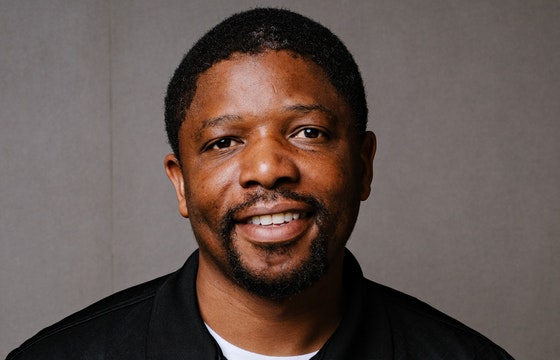

![Make [Education] Reporting Great Again](https://kappanonline.org/wp-content/uploads/2024/03/make-education-reporting-great-again-2016-440x264.jpg)

